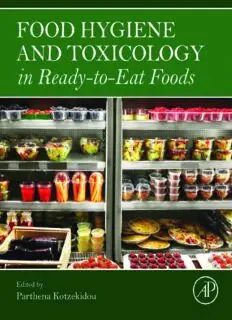
Food hygiene and toxicology in ready to eat foods PDF
Preview Food hygiene and toxicology in ready to eat foods
Food Hygiene and Toxicology in Ready-to-Eat Foods This pageintentionallyleftblank Food Hygiene and Toxicology in Ready-to-Eat Foods Parthena Kotzekidou Department of Food Science and Technology, Faculty of Agriculture, Aristotle University of Thessaloniki, Thessaloniki, Greece AMSTERDAM(cid:129)BOSTON(cid:129)HEIDELBERG(cid:129)LONDON NEWYORK(cid:129)OXFORD(cid:129)PARIS(cid:129)SANDIEGO SANFRANCISCO(cid:129)SINGAPORE(cid:129)SYDNEY(cid:129)TOKYO AcademicPressisanimprintofElsevier AcademicPressisanimprintofElsevier 125LondonWall,LondonEC2Y5AS,UK 525BStreet,Suite1800,SanDiego,CA92101-4495,USA 50HampshireStreet,5thFloor,Cambridge,MA02139,USA TheBoulevard,LangfordLane,Kidlington,OxfordOX51GB,UK Copyright©2016ElsevierInc.Allrightsreserved. Nopartofthispublicationmaybereproducedortransmittedinanyformorbyanymeans,electronic ormechanical,includingphotocopying,recording,oranyinformationstorageandretrievalsystem,without permissioninwritingfromthepublisher.Detailsonhowtoseekpermission,furtherinformationaboutthe Publisher’spermissionspoliciesandourarrangementswithorganizationssuchastheCopyrightClearance CenterandtheCopyrightLicensingAgency,canbefoundatourwebsite:www.elsevier.com/permissions. Thisbookandtheindividualcontributionscontainedinitareprotectedundercopyrightbythe Publisher(otherthanasmaybenotedherein). Notices Knowledgeandbestpracticeinthisfieldareconstantlychanging.Asnewresearchandexperiencebroaden ourunderstanding,changesinresearchmethods,professionalpractices,ormedicaltreatmentmaybecome necessary. Practitionersandresearchersmustalwaysrelyontheirownexperienceandknowledgeinevaluating andusinganyinformation,methods,compounds,orexperimentsdescribedherein.Inusingsuchinformation ormethodstheyshouldbemindfuloftheirownsafetyandthesafetyofothers,includingpartiesforwhom theyhaveaprofessionalresponsibility. Tothefullestextentofthelaw,neitherthePublishernortheauthors,contributors,oreditors,assumeany liabilityforanyinjuryand/ordamagetopersonsorpropertyasamatterofproductsliability,negligence orotherwise,orfromanyuseoroperationofanymethods,products,instructions,orideascontained inthematerialherein. BritishLibraryCataloguing-in-PublicationData AcataloguerecordforthisbookisavailablefromtheBritishLibrary. LibraryofCongressCataloging-in-PublicationData AcatalogrecordforthisbookisavailablefromtheLibraryofCongress. ISBN:978-0-12-801916-0 ForInformationonallAcademicPresspublications visitourwebsiteathttp://elsevier.com/ Publisher:NikkiLevy AcquisitionEditor:PatriciaOsborn EditorialProjectManager:KarenMiller ProductionProjectManager:MelissaRead Designer:MatthewLimbert TypesetbyMPSLimited,Chennai,India Contents List ofContributors.................................................................................................xv Preface....................................................................................................................xix PART I TRENDS IN FOOD HABITS CHAPTER 1 Food habits and the increase in ready-to-eat and easy-to-prepare products........................................3 CaterinaContini, CaterinaRomano, Gabriele Scozzafava and Leonardo Casini Introduction....................................................................................3 IsThere a Common Denominator inRTE and ETP Meals?.......4 What are the MotivesBehind the GrowingDemand for RTE and ETP Meals?.........................................................4 Beliefs, Attitudes, and Behavior..............................................5 Value SystemandFood-RelatedLifestyles.............................7 TheMotivations ofSuccess.....................................................8 IsThere a Typical Profile ofIndividuals Who Choose to Consume RTE andETP Foods?.............................................10 Discussion andConclusions........................................................11 References....................................................................................12 CHAPTER 2 Safety of street foods.....................................................15 Mohammad AlMamun andTanvir Chowdhury Turin Street Foods: Definitionand Basic Characteristics....................15 Safety ofStreet Foods: AMajor Concern..................................18 Microbiological ContaminationofStreet Foods....................19 Chemicaland Physical Hazards inStreet Foods...................21 Ensuring andImproving Safety ofStreet Foods........................22 Educationand Training ofStreet FoodVendors...................23 WHO’s “Five Keys toSafer Food”inStreet Food Operations.............................................................................24 Programs,Guidelines, andManuals for Safety of Street Foods..........................................................................25 Implementation ofHACCP Approach inStreet Food Sector....................................................................................26 v vi Contents Regulation,Registration, and Licensingof Street Food Vendors.................................................................................26 Awareness Raising Among Street Food Consumers.............27 References....................................................................................28 PART II MICROBIOLOGICAL HAZARDS CHAPTER 3 Factors influencing microbial safety of ready-to-eat foods..........................................................33 Parthena Kotzekidou Introduction..................................................................................33 Environmental Factors Affecting Safety ofRTE Foods............35 Sourcesof Microbial ContaminationofRTE Foods..................37 HurdlesAffecting Microbial Growthin RTE Foods..................40 Personnel Hygiene.......................................................................44 Conclusions..................................................................................46 References....................................................................................47 CHAPTER 4 Foodborne viruses in ready-to-eat foods....................51 Leena MaunulaandCarl-Henrik von Bonsdorff Introduction..................................................................................51 GeneralAspectsof FoodborneViruses......................................51 Norovirus................................................................................52 Hepatitis AVirus....................................................................53 Hepatitis E Virus....................................................................53 Risk Ready-to-Eat Food Items....................................................54 Persistence ofFoodborne Viruseson Food and Surfaces..........55 Virus Transmission Into Food Supply Chain.............................56 Role ofFood HandlersinTransmission Routes ofViruses.......57 Foodborne Outbreaks Related toRTE Foods.............................57 Methods for Detection ofVirusesFrom Food............................59 PreventionofViral Transmission Through Food.......................59 Future Perspectives......................................................................61 References....................................................................................62 CHAPTER 5 Parasitic protozoa in salad vegetables.......................69 Lucy J. Robertson Introduction..................................................................................69 Contents vii Parasitic Protozoa That May Contaminate Salad Vegetables....70 Balantidium coli.....................................................................72 Cryptosporidium spp..............................................................72 Cyclospora cayetanensis........................................................76 Entamoeba histolytica............................................................79 Giardia duodenalis.................................................................80 Toxoplasmagondii..................................................................82 Conclusions..................................................................................83 References....................................................................................84 CHAPTER 6 Foodborne pathogens in ready-to-eat peanut butter-containing products...............................89 Elizabeth M.Grasso-Kelley Introduction..................................................................................89 Outbreaks.....................................................................................90 Recalls..........................................................................................94 Prevalenceof Pathogens..............................................................94 Cross-Contamination...................................................................95 Survival Studies...........................................................................96 Intervention Strategies.................................................................97 Thermal Inactivation..............................................................97 Nonthermal Inactivation.........................................................98 Preventive Controls.....................................................................99 Conclusions................................................................................100 References..................................................................................101 CHAPTER 7 Handling of hamburgers and cooking practices......107 Daniel A.Unruh, Justin J. Kastner,Jacob R. Jenott and Sara E. Gragg Introduction................................................................................107 Hamburger:Characteristics and Cookery.................................108 Hamburger andGroundBeef...............................................108 Ground Beef Production.......................................................108 Handling and Cooking of Hamburger..................................110 Public Health Implicationsof PoorHamburger Hygiene.........112 Common Pathogens Found inGroundBeef........................112 Hamburger andPathogen Reduction...................................115 Regulations and Research....................................................115 References..................................................................................118 viii Contents CHAPTER 8 Salmonella and Listeria monocytogenes in ready-to-eat leafy vegetables..................................123 RafaelDjalma Chaves, RafaelChacon Ruiz Martinez, AnaCarolinaBortolossi Rezende,MonycaDiasRocha, Juan M.Oteiza andAnderson de SouzaSant’Ana Introduction.............................................................................123 Salmonella..........................................................................125 Listeria monocytogenes.....................................................126 Salmonella andL. monocytogenesSources and Contamination Pathways inthe Field.....................................129 Control ofSalmonella and L. monocytogenes Contamination in RTE Vegetables.........................................133 Conclusion...............................................................................138 References...............................................................................139 CHAPTER 9 Foodborne pathogenic bacteria in fresh-cut vegetables and fruits.................................................151 Hu¨lya O¨lmez Introduction.............................................................................151 Sources and Routes ofPathogen Contamination inFresh-Cut Produce..............................................................152 FoodborneOutbreaks Associatedwith Pathogenic Bacteria inFresh-Cut Fruits andVegetables.........................154 Attachment, Internalization, and Biofilm Development byFoodbornePathogenic Bacteriaon Fresh-Cut Fruit andVegetables........................................................................157 Challengesin Fresh-Cut Fruitand Vegetable Safety.............161 References...............................................................................162 CHAPTER 10 Stress adaptation of Listeria monocytogenes in acidic ready-to-eat products...............................167 RanjuPaudyal and KimonAndreas G.Karatzas Ready-to-Eat Foods................................................................167 High-Risk Foods................................................................168 Low-Risk Foods.................................................................168 Acidic Foods......................................................................168 Listeria monocytogenes..........................................................169 Listeria monocytogenes inRTE Foods..................................169 Listeria monocytogenes inAcidicRTE Foods.......................171 Acid Resistance ofL. monocytogenes....................................171 Contents ix TheGAD System....................................................................172 Arginine Deiminase System...................................................175 Other Factors Involved inAcid Resistance of L. monocytogenes....................................................................176 Agmatine DeiminaseSystem.............................................176 SigB and Acid Resistance.................................................177 Other Mechanisms ofAcid Resistance.............................177 Conclusions.............................................................................178 References...............................................................................179 CHAPTER 11 Safety of fresh-squeezed juices..............................183 Nanci Edid Mart´ınez-Gonza´les and AlejandroCastillo Introduction.............................................................................183 Outbreaks AssociatedWith Fresh-Squeezed Juices...............184 Sources ofPathogens in Fresh-Squeezed Juices....................190 Prevalence ofHumanPathogens in Freshly Squeezed FruitJuices..............................................................................193 Internalization ofPathogens in Fruits Used toObtain Fresh Juice...............................................................................198 Survival ofPathogen inFresh Juicesand inProduce Usedto Prepare Juices............................................................199 ContaminationReductionStrategies......................................201 Conclusions.............................................................................202 References...............................................................................202 CHAPTER 12 Safety improvement of fruit juices by novel thermal and nonthermal processing........................209 Vicknesha Santhirasegaram, Zuliana Razali and Chandran Somasundram Introduction.............................................................................209 FruitJuice Deterioration and Spoilage...................................210 FruitJuice Processing.............................................................211 Thermal Processing............................................................211 Nonthermal Processing......................................................212 Combination ofProcessing Methods orHurdle Concept..............................................................................219 Conclusion and FuturePerspectives.......................................220 References...............................................................................220
